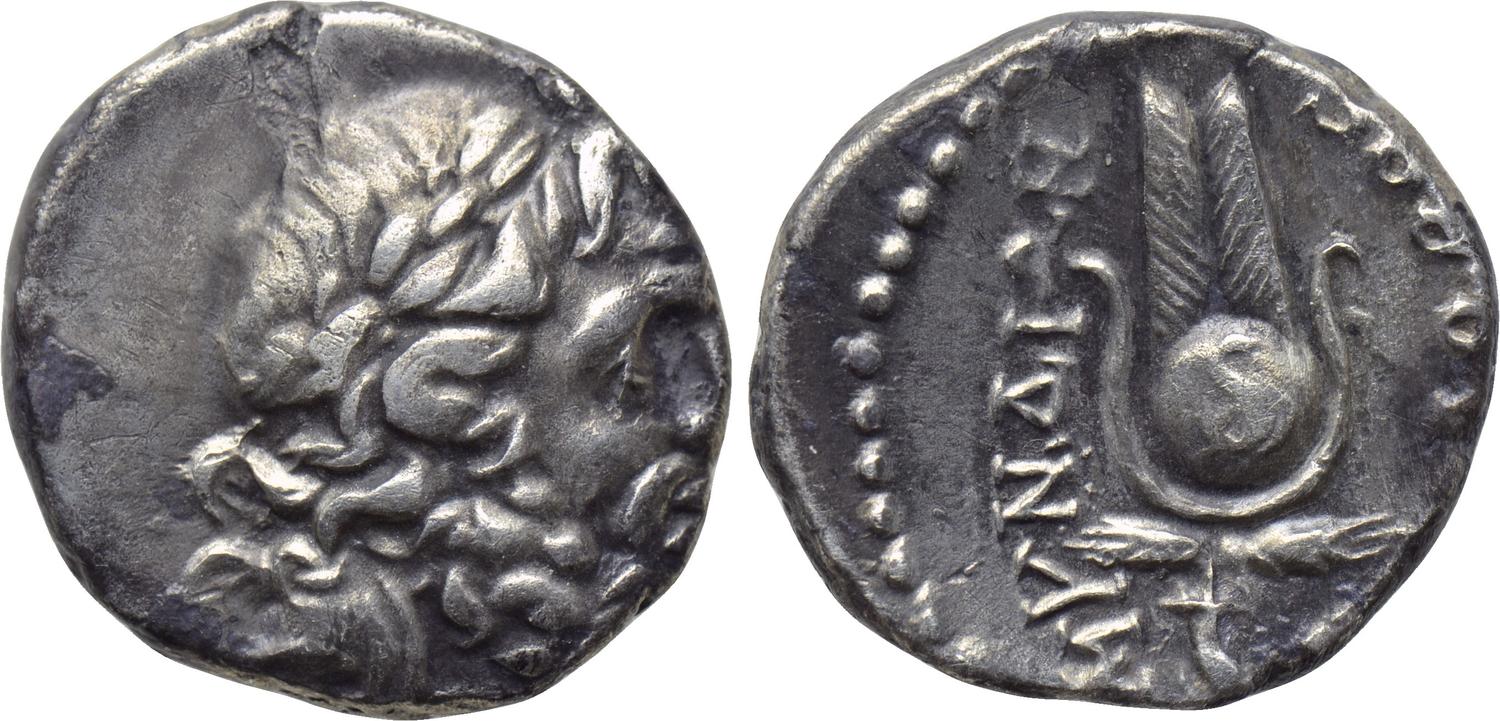Myndus, silver, drachms (Serapis/isis crown) (180-150 BCE)
From SILVER
180 BCE - 150 BCE Silver 2,963 kg
Description
| ObverseInscription or printing placed on the obverse.: | Laureate head of Serapis right |
| ReverseInscription or printing placed on the reverse.: | ΜΥΝΔΙΩΝ + controler name (Greek).Isis crown above two grain ears, cornucopia below |
Mint and issuing power
| MintIdentifies the place of manufacture or issue of a numismatic object.: | Myndus | Ancient regionAncient region.: | Caria | Modern countryModern country: Turkey | AuthorityIdentifies the issuing power. The authority can be "pretended" when the name or the portrait of X is on the coin but he/she was not the issuing power. It can also be "uncertain" when there is no mention of X on the coin but he/she was the issuing power according to the historical sources: |
Chronology
| FromIdentifies the initial date in a range assigned in a numismatic context. | 180 BCE | toIdentifies the final date in a range assigned in a numismatic context.. | 150 BCE | PeriodTime period of the numismatic object.: Hellenistic 323-30 BC |
Physical description
| MetalThe physical material (usually metal) from which an object is made.: | Silver |
Median weightMedian of the weights of numismatic objects (in grams). in grams | 3.90 | DenominationTerm indicating the value of a numismatic object. Examples: tetradrachm, chalkous, denarius.: | drachma |
StandardStandard.: | Attic |
Image

S1916 Myndos Serapis Isis.jpg [1]
References
| Die study referencePublication of the study: | Zabel - Meadows 20021Zabel - Meadows 2002 | ||
| Coin series referenceReference to coin series study: | Sear I2Sear I, n° 4915 | ||
| Coin series web referenceCoin series web references: | |||
Obverse dies distribution
| FrequencyFrequency of specimen in distribution. ᵖ | Number of obversesNumber of obverse dies. ᵖ (o) | % (o) | Number of coinsNumber of coins. (n) | % (n) | Die nameName(s) of the die(s). |
| 1 | 14 | 43.75 | 14 | 11.76 | 3, 9, 13, 14, 16, 17, 20, 21, 22, 23, 27, 29, 34, 36 |
| 2 | 3 | 9.38 | 6 | 5.04 | 4, 28, 33 |
| 3 | 5 | 15.63 | 15 | 12.61 | 1, 2, 10, 18, 26 |
| 4 | 1 | 3.13 | 4 | 3.36 | 26 |
| 5 | 2 | 6.25 | 10 | 8.4 | 11, 19 |
| 6 | 3 | 9.38 | 18 | 15.13 | 8, 15, 30 |
| 11 | 1 | 3.13 | 11 | 9.24 | 31 |
| 12 | 1 | 3.13 | 12 | 10.08 | 32 |
| 13 | 1 | 3.13 | 13 | 10.92 | 25 |
| 16 | 1 | 3.13 | 16 | 13.45 | 12 |
| Total | 32 of 32 | 100.04 | 119 of 119 | 99.99 |
Reverse dies distribution
no distribution is available
Quantification
| Number of obversesNumber of obverse dies. ᵖ (o) | 32 | Number of singletons (o1)The number of singleton coins. ᵖ | 14 |
| Number of reverse diesNumber of reverse dies. (r) | 104 | Number of coinsNumber of coins. (n) | 119 |
| Coins per obverse dieNumber of coins per obverse die. (n/o) | 3.72 | Coins per reverse dieNumber of coins per reverse die. (n/r) | 1.14 |
| Reverse per obverse ratioRatio of obverse dies divided by reverse dies. (r/o) | 3.25 | Percentage of singletons (o1)number of coins (n) divided by the number of singletons (o1) ᵖ | 43.75 % |
| Original number of dies (O) (Carter 1983 formula)The estimation of the number of coins according to Carter 1983 ᵖ | 37.99 | Coins struck if 20,000 as average productivity per dieCoins made if the average productivity for obverses (according to Carter) is 20,000. ᵖ | 759,800 |
| Original number of dies (O) (Esty 2011 formula)The estimation of the number of coins according to the singleton formula in Esty 2011 ᵖ (O) | 43.77 | Survival rate if 20,000 as average productivity per dieSurvival rate if average productivity is 20,000. ᵖ | 0.00016 |
| Coverage (o = % of O) (Esty 1984 formula)Esty 1984 - coverage (% of O) ᵖ (o = % of O) | 88.24% | Die productivity if survival rate 1/2,000Average productivity if survival rate is 1/2,000. ᵖ | 6,264.81 |
| Weight of silver (in kg) if 20,000 coins per die (O = Carter formula)Carter 1983 * Median weight * 20000 (*10 if gold or electrum) ᵖ | 2,963 kg <br /> 2,963 kg | Die productivity if survival rate 1/5,000Average productivity if survival rate is 1/5,000. ᵖ | 15,662.02 |
Remarks
Likely military
Obv. 5-7, 24 are missing